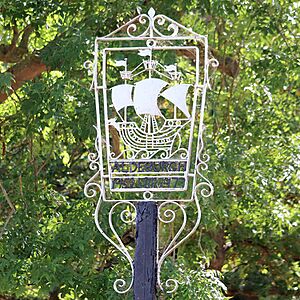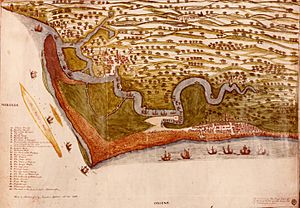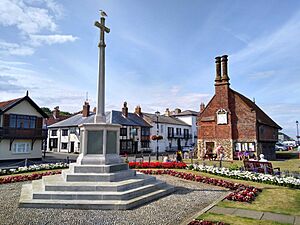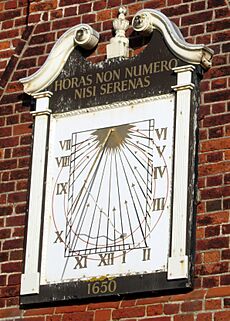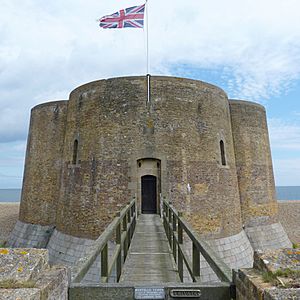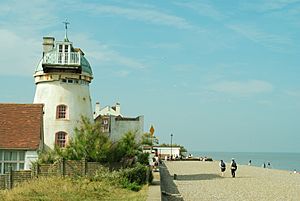Aldeburgh facts for kids
Quick facts for kids Aldeburgh |
|
|---|---|
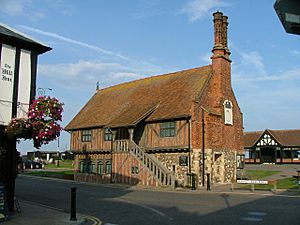 The Moot Hall |
|
The town's flag |
|
| Population | 2,466 (2011 Census) |
| OS grid reference | TM463566 |
| Civil parish |
|
| District |
|
| Shire county | |
| Region | |
| Country | England |
| Sovereign state | United Kingdom |
| Post town | ALDEBURGH |
| Postcode district | IP15 |
| Dialling code | 01728 |
| Police | Suffolk |
| Fire | Suffolk |
| Ambulance | East of England |
| EU Parliament | East of England |
| UK Parliament |
|
Aldeburgh is a lovely coastal town in Suffolk, England. It's located north of the River Alde. In 2019, about 2,276 people lived there. This town was once home to the famous composer Benjamin Britten. Today, it's known for the international Aldeburgh Festival of arts, which Britten started in 1948. The festival takes place at Snape Maltings, a short distance away. Aldeburgh also hosts a yearly poetry festival and fun food events.
Aldeburgh became a special 'borough' town in 1529, thanks to Henry VIII. It has old buildings like the Moot Hall, which is from the 1500s. There's also a Martello Tower built during the time of Napoleon. Many people visit Aldeburgh for its beautiful Blue Flag beach and the fishing huts where you can buy fresh fish. The Aldeburgh Yacht Club is popular, and the town has great cultural events. Two local fish and chip shops are even considered among the best in the country! The Aldeburgh bookshop has been open for over seventy years. It's thought to be the birthplace of the poet George Crabbe (1754–1832). Since 2002, this bookshop has also organized the yearly Aldeburgh Literary Festival.
Contents
- Aldeburgh's Past: A Look at History
- Where is Aldeburgh? Exploring its Geography
- Who Runs Aldeburgh? Understanding Governance
- Getting Around: Transport in Aldeburgh
- Famous Places: Landmarks in Aldeburgh
- Aldeburgh in World War I
- Famous People: Notable Residents of Aldeburgh
- Arts and Activities: Culture in Aldeburgh
- News and Entertainment: Media in Aldeburgh
- Other Useful Places: Amenities in Aldeburgh
- Aldeburgh's Coat of Arms
- See also
Aldeburgh's Past: A Look at History
The name "Aldeburgh" means "old fort" in Old English. Sadly, this old fort and much of the town from the Tudor period have been lost to the sea over time. In the 1500s, Aldeburgh was a very important port. It had a busy shipbuilding industry. The Sea Venture, a famous ship from the Virginia Company of London, is believed to have been built here in 1608.
Aldeburgh's importance as a port slowly faded. This happened because the River Alde became too shallow for large ships. The town then relied mostly on fishing. In the 1800s, it also became a popular seaside resort. Many of its unique buildings are from this time. Today, the river is home to a yacht club and a sailing club.
Between 1959 and 1968, a Royal Observer Corps bunker was in the village. It was meant to be used if there was a nuclear attack. This bunker was later taken down, and nothing remains of it.
Where is Aldeburgh? Exploring its Geography

Aldeburgh is on the North Sea coast. It's about 140 kilometers north-east of London. It's also 32 kilometers north-east of Ipswich and 37 kilometers south of Lowestoft. Nearby, it's 6 kilometers south of Leiston and 3 kilometers south of Thorpeness. The town sits just north of the River Alde. A narrow shingle (pebble) strip of land called Orford Ness stops the river from meeting the sea right at Aldeburgh. Instead, the river flows another 14 kilometers to the south-west.
The beach in Aldeburgh is mostly shingle. In some places, it's wide enough for fishing boats to be pulled up above the high tide line. But it gets narrower near Orford Ness. You can reach Orford Ness from the north by walking along the shingle bank. Along the way, you'll see a Martello tower and two yacht clubs where the old village of Slaughden used to be. Aldeburgh was flooded in the North Sea flood of 1953. After that, stronger flood defenses were built. The beach earned a Blue Flag beach award in 2005 for its cleanliness and safety.
The town is part of the Suffolk Coast and Heaths Area of Outstanding Natural Beauty (AONB). This means it's a special area protected for its natural beauty. There are also several Sites of Special Scientific Interest (SSSI) and nature reserves nearby. The Alde-Ore Estuary SSSI covers the river area from Snape to the sea, including all of Orford Ness. This area has important salt marsh and mudflat habitats. The Leiston-Aldeburgh SSSI stretches from the north of the town. It includes different habitats like grazing marsh and heathland. It also has Thorpeness Mere and the North Warren RSPB reserve. This reserve is a place for wildlife and habitat conservation, with nature trails run by the Royal Society for the Protection of Birds.
There are two smaller geological SSSI sites on the southern edge of town. Aldeburgh Brick Pit is a small area that clearly shows layers of Red Crag deposits above Corralline Crag. Aldeburgh Hall Pit is another small area. It features a section of Corralline Crag. This site is considered one of the best in Britain for studying ancient Neogene animals.
The town has two churches. One is the old Anglican parish church of St Peter and St Paul. The other is the Catholic Church of Our Lady and St Peter.
Who Runs Aldeburgh? Understanding Governance
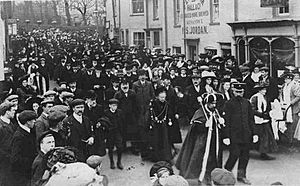
Aldeburgh has a town council. It is part of the East Suffolk district. In the 2011 census, the Aldeburgh area, including Thorpeness, had a population of 3,225 people. The average age of residents was 55, and the middle age (median) was 61.
The town is in the Suffolk Coastal parliamentary area. Since 2024, the Member of Parliament (MP) for this area has been Jenny Riddell-Carpenter from the Labour party. Before this, it was considered a safe area for the Conservatives.
Aldeburgh used to be a special parliamentary borough from 1571. It sent two Members of Parliament (MPs) to the government. Only the town's freemen could vote. By the mid-1700s, it was called a "rotten borough." This meant that a rich merchant, Thomas Fonnereau, controlled the votes. He even called it "a venal little borough in Suffolk," meaning it was easily bought. Aldeburgh lost its right to send MPs in 1832, after the Great Reform Act.
In 1908, Aldeburgh made history. It became the first British town to elect a female mayor: Elizabeth Garrett Anderson. Her father, Newson Garrett, had also been mayor in 1889. In 2006, Sam Wright became Aldeburgh's town crier and mace bearer at just 15 years old. This made him the youngest in the world.
In 1885, Aldeburgh became a municipal borough. It joined the county of East Suffolk in 1889. On April 1, 1934, part of Hazlewood parish was added to Aldeburgh. On April 1, 1974, the district was ended. Aldeburgh then became part of Suffolk Coastal. In 2019, Aldeburgh became part of the new East Suffolk district.
Getting Around: Transport in Aldeburgh
Aldeburgh is connected to the A12 main road by the A1094 road. This connection is at Friday Street in Benhall. The B1122 road leads to Leiston.
You can catch direct bus services from Aldeburgh to towns like Saxmundham, Beccles, Halesworth, Woodbridge, and Ipswich. Buses in this area are run by First Eastern Counties and Borderbus.
The Aldeburgh railway station opened in 1860. It was the end point of the Aldeburgh Branch Line from Saxmundham. However, the station closed in 1966 as part of the Beeching Axe, which closed many railway lines. Today, the closest train station is Saxmundham. It's about seven miles away on the East Suffolk Line. From Saxmundham, you can catch hourly trains on weekdays to Ipswich. From Ipswich, you can connect to trains going towards London Liverpool Street. You can also go to Lowestoft from Saxmundham, with connections to Norwich.
Famous Places: Landmarks in Aldeburgh
Aldeburgh Lifeboat Station
The RNLI (Royal National Lifeboat Institution) station in Aldeburgh had two lifeboats in 2016. These boats help rescue people at sea.
The Moot Hall: A Historic Meeting Place
The Moot Hall is a very old timber-framed building. It's so important that it's listed as a Grade I building. It has been used for town council meetings for over 400 years. The Town Clerk's office is still there, and it also houses the local museum. The hall was built around 1520 and changed in 1654. The brick and stone parts on the ground floor were added later. The hall was repaired in 1854–1855. There are 64 other historic buildings and monuments listed in the town.
Martello Tower: A Unique Fort
A very unique, four-leaf clover shaped Martello Tower stands at the narrow strip of land leading to the Orford Ness shingle spit. It is the largest and most northern of 103 English defensive towers. These towers were built between 1808 and 1812 to protect against a possible invasion by Napoleon. The Landmark Trust now rents it out as holiday apartments. From May 2015 to May 2016, a statue by Antony Gormley was placed on its roof as part of an art project.
The Martello Tower is the only building left from the fishing village of Slaughden. This village was washed away by the North Sea by 1936. Near the Martello Tower at Slaughden Quay, you can barely see the remains of a fishing boat called Ionia. It got stuck in the muddy River Alde and was then used as a houseboat. It was burned in 1974 because it became unsafe.
Fort Green Mill: A Converted Windmill
This four-story windmill is at the southern end of the town. It was built in 1824. In 1902, it was changed into a house.
WW2 Tank Trap
You can see a tank trap from World War II next to Slaughden Road.
Aldeburgh Beach Lookout: A Historic Viewpoint
The Aldeburgh Beach Lookout is an old building on the Aldeburgh seafront. It's a Grade II listed building. It was built around 1830 as a lookout tower. Its purpose was to help ships or to find things from shipwrecks along the dangerous North Sea coast. The South African writer Laurens van der Post wrote his books there for over thirty years. Since 2010, the lookout has been an art space for locals and visitors. You can see Antony Gormley sculptures between the lookout and the sea.
The Scallop: A Special Sculpture
On Aldeburgh's beach, a bit north of the town center, there's a sculpture called Scallop. It's dedicated to Benjamin Britten, who loved to walk along this beach. The sculpture was made from stainless steel by Maggi Hambling, an artist from Suffolk. It stands about 4.6 meters high and was revealed in November 2003. The artwork is made of two scallop shells that fit together, but each is broken. The upright shell has words carved into it: "I hear those voices that will not be drowned." These words are from Britten's opera Peter Grimes. The sculpture is meant to be enjoyed by looking at it and by touching it. People are encouraged to sit on it and watch the sea.
The upright part of the shell splits into three sections at different angles. This makes the sculpture look different depending on where you stand to view it.
This sculpture has caused some debate in the local area. Some residents think it "spoils the beach." It has been damaged with graffiti and paint thirteen times. There have been groups asking for it to be removed, and other groups wanting it to stay.
Aldeburgh in World War I
During the First World War, a nearby airfield called Royal Naval Air Station Aldeburgh was used. It was a place for planes to land at night and for training observers.
Famous People: Notable Residents of Aldeburgh

Many interesting people have lived in or been connected to Aldeburgh:
- George Crabbe (1754–1832), a poet, was born in Aldeburgh. The town appears in his poems The Village and The Borough. The story of a fisherman named Peter Grimes from The Borough inspired Benjamin Britten's opera.
- John Liptrot Hatton (1809–1886) was a famous composer, conductor, pianist, and singer. He stayed in Aldeburgh and wrote an Aldeburgh Te Deum for the town.
- Elizabeth Garrett Anderson (1836–1917) was a pioneer. She was the first woman to become a doctor and surgeon in Britain. She was also the first female mayor and judge in Britain, serving in Aldeburgh. She is buried in the town churchyard.
- Mabel Lilian Basham, a filmmaker, recorded daily life and important events in Aldeburgh.
- Benjamin Britten (1913–1976) moved to Aldeburgh in 1942. He, Eric Crozier (1914–1994), and Peter Pears (1910–1986) started the Aldeburgh Festival and Aldeburgh Music Club. Britten and Pears moved into The Red House in 1957. They are buried side by side in the town churchyard.
- Imogen Holst (1907–1984), a composer, conductor, and teacher, helped direct the Aldeburgh Festival. She lived in Aldeburgh from 1952 and is buried there.
- Ruth Rendell (1930–2015), a writer of thrillers and mystery novels, created the character Chief Inspector Wexford.
- Peter Sinfield (1943-2024), a songwriter known for his work with the band King Crimson.
- Roy Keane (born 1971), a famous footballer, became an Aldeburgh resident in 2009 when he became manager of Ipswich Town.
- Miranda Raison (born 1977), an actress, has a weekend home in Aldeburgh.
Arts and Activities: Culture in Aldeburgh
Outside the town, Snape Maltings is the main place for the Aldeburgh Festival, which happens every June.
The Aldeburgh Music Club was started by Benjamin Britten and Peter Pears in 1952. It has grown into one of the best choirs in East Anglia. It has about 100 members and performs three major concerts each year, two of them at Snape Maltings Concert Hall.
The yearly Aldeburgh Carnival in August has been held since at least 1892. It might even have started in 1832. Today, the main event is a carnival parade. Locals and visitors dress up in homemade costumes and ride on floats. These often have themes about current events or local topics. In the evening, there's a parade with Chinese lanterns and a firework show.
The Suffolk Craft Society holds a yearly art exhibition in the Peter Pears Gallery. It runs over July and August and shows the work of its members.
The town of Aldeburgh, sometimes called "Owlbarrow," is the setting for a series of children's books. These books are about Orlando (The Marmalade Cat) and were written by Kathleen Hale, who spent holidays in the town. Many pictures in the books show famous places in Aldeburgh, like the Moot Hall. The town also appears in the 1989 thriller Cross of Fire by Colin Forbes.
Fishing in Aldeburgh
Aldeburgh is a great place for amateur anglers (people who fish for fun). It's known as a good spot for catching bass, flounders, sole, dabs, cod, whiting, and eels. However, some worry that too much commercial fishing has harmed the local sea fisheries. This could affect the fishing community. Local fishermen have supported campaigns to protect small-scale fishing.
Rugby in Aldeburgh
Aldeburgh is home to the Aldeburgh and Thorpeness Rugby Club. It's based at Kings Field in Aldeburgh. The club has an adult team, an Under-15s team, and teams for younger players. They also have a women's touch rugby team. The club started in nearby Thorpeness and moved to Aldeburgh in 2015.
News and Entertainment: Media in Aldeburgh
Local news and TV shows for Aldeburgh come from BBC East and ITV Anglia. TV signals are received from the Tacolneston TV transmitter and a local relay transmitter north-east of the town.
Local radio stations include BBC Radio Suffolk, Heart East, Greatest Hits Radio Ipswich & Suffolk, and Alde and Blyth Community Radio (ABC). ABC is a community radio station.
The local newspaper that serves the town is the East Anglian Daily Times.
Other Useful Places: Amenities in Aldeburgh
Aldeburgh has several useful places for residents and visitors. These include Aldeburgh Cottage Hospital, which is a traditional English hospital. There's also the Aldeburgh Library, which has volunteers helping out. The Aldeburgh cinema shows films and hosts cultural events.
Aldeburgh's Coat of Arms
|
See also
 In Spanish: Aldeburgh para niños
In Spanish: Aldeburgh para niños


